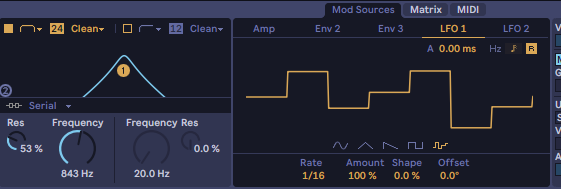Wavetable Synthesis - Detuning Duplicate Wavetables
Wavetable synthesis has become my favorite tool to use for sound design since you can get very unique characteristics out of a normal subtractive synthesis signal path. Being able to take a short clip and load it into a wavetable synth and then having the ability to modulate the smaller waveforms within the loaded sample create textures that are more organic sounding due to the imperfections of the oscillators. While Serum may be the first wavetable synth that comes to everyone's mind, Ableton's aptly names Wavetable plugin is my primary synth for almost everything. Through all the hours I've spent with this plugin I've come across some nice sounds that should be applicable to any wavetable synth.
My favorite way to make leads back in the FL studio days (~2010) was to take 2 or 3 sawtooth oscillators and slight detune them. This is using the cents parameter on the oscillators' tuning to create a more wider and dynamic sound due to the phases of the waveforms syncing and desynching. When working with Wavetable during a session I was, curious about using a pair of complex waveforms as a opposed to my typical 1 traditional waveform (pulse, saw, triangle, sine) paired with a wavetable of a more complex nature. Remembering my hypersaw habits from the past I began experimenting with slightly detuning one of the pairs of the duplicate wave tables. the basic formula for experimenting with this is:
- same waveform
- same cycle poisition
- one wavetable detuned in cents not semi-tones
From there, LFOs and Envelops can then be used on both wavetables' positioning parameter to cycle through the waveform in lockstep. The more complex waveforms that already have a lot of harmonics tend to get really chaotic really fast. So search for waveforms that look more like sine waves.
One of the interesting sounds I came across was using more "organic" wavetables. They created a very animal-like sound when used in lower octaves with a LP filter and more hyper-saw lead-like sounds in the higher octaves.
using the "AEIOU" wavetables set at 50% position and detuning the 2nd wavetable to +35ct.
 I also like to turn on wavetable's sub oscillator to provide a more grounded low-end if it's needed.
I also like to turn on wavetable's sub oscillator to provide a more grounded low-end if it's needed.
 A lot of sounds using this technique will probably require either parallel processing or a dedicated bass synth altogether due to the muddiness that ends up in the low-end.
A lot of sounds using this technique will probably require either parallel processing or a dedicated bass synth altogether due to the muddiness that ends up in the low-end.
Without detuning the synced waveforms sound like this
but once we add some detuning, the sound starts to take on some new characteristics without sounding to harsh.
Now taking advantage of the strengths of wavetable synthesis and setting an LFO to both wavetable positions for the same value, the sound takes on a whole new life.

Then applying a bandpass filter, some resonance, and an LFO set to 16th note random values controlling the filter cutoff, we can create a more glitchy sound that sounds great when paired with delay and reverb.

